Assessing the Low-Cost Long-Haul Business Model's Sustainability
VerifiedAdded on 2023/06/05
|7
|1755
|161
Essay
AI Summary
This essay examines the low-cost long-haul business model in the aviation industry, focusing on its feasibility, sustainability, and potential to withstand economic downturns. It argues that new generation aircraft have made this model more feasible by reducing operational costs and meeting customer needs for affordable long-distance travel. The essay further discusses the sustainability of the model, highlighting its ability to shift pricing in the aviation industry and attract customers. However, it also acknowledges that the model is vulnerable to economic downturns and shifts in traveler preferences, suggesting that its success is heavily reliant on discretionary travelers. The essay concludes by referencing various academic sources to support its analysis of the low-cost long-haul business model and its impact on the aviation industry. Desklib provides access to this essay and many more resources for students.
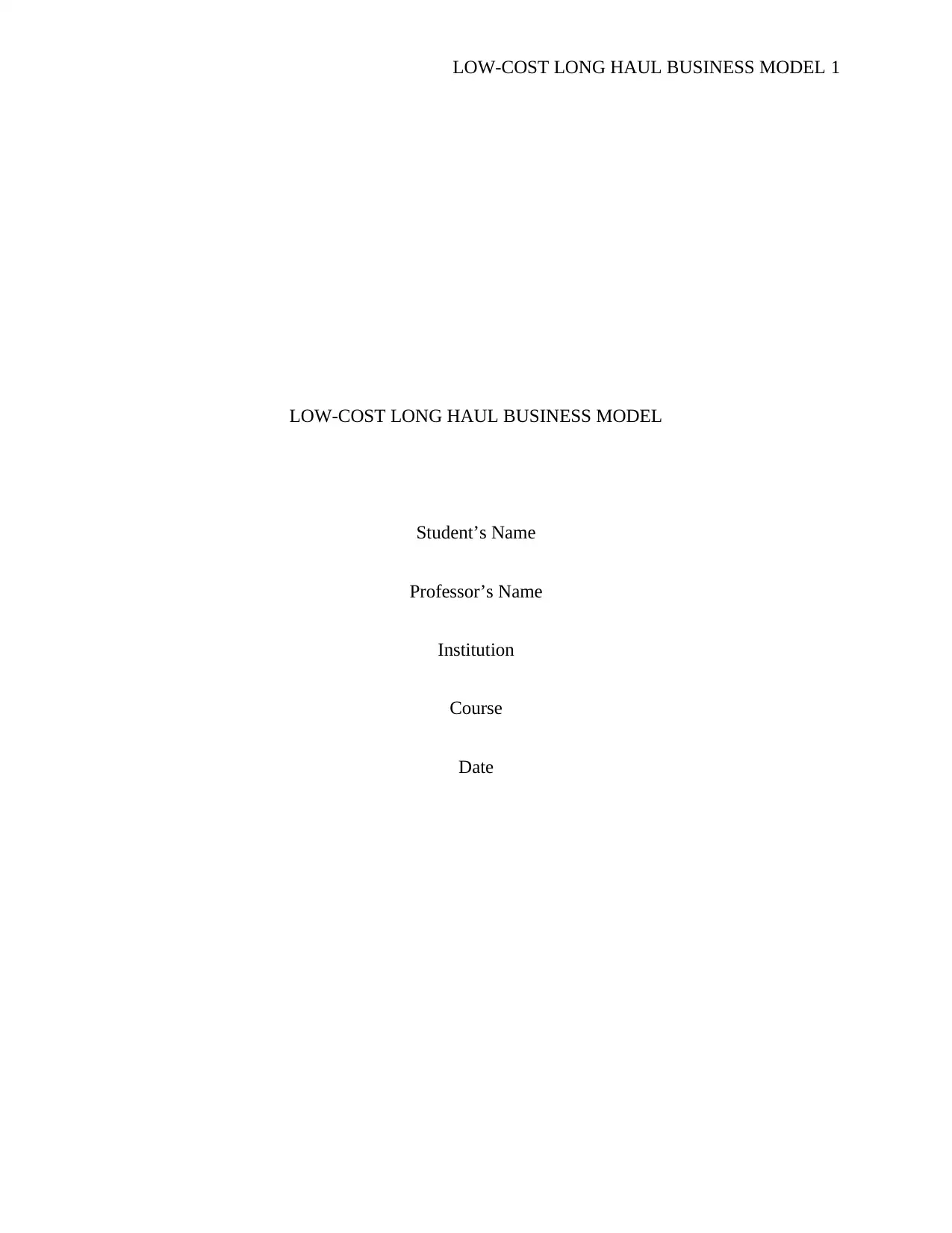
LOW-COST LONG HAUL BUSINESS MODEL 1
LOW-COST LONG HAUL BUSINESS MODEL
Student’s Name
Professor’s Name
Institution
Course
Date
LOW-COST LONG HAUL BUSINESS MODEL
Student’s Name
Professor’s Name
Institution
Course
Date
Paraphrase This Document
Need a fresh take? Get an instant paraphrase of this document with our AI Paraphraser
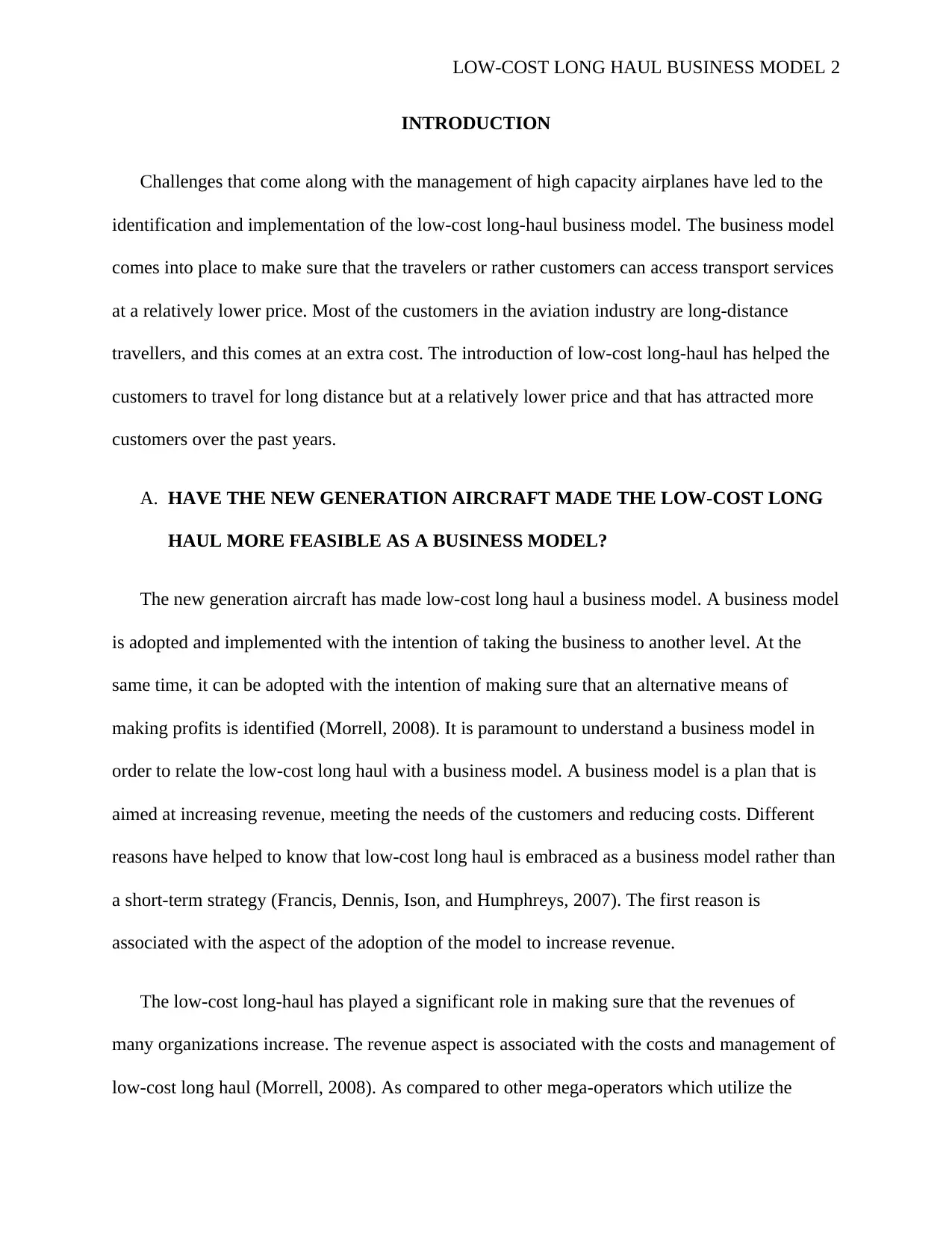
LOW-COST LONG HAUL BUSINESS MODEL 2
INTRODUCTION
Challenges that come along with the management of high capacity airplanes have led to the
identification and implementation of the low-cost long-haul business model. The business model
comes into place to make sure that the travelers or rather customers can access transport services
at a relatively lower price. Most of the customers in the aviation industry are long-distance
travellers, and this comes at an extra cost. The introduction of low-cost long-haul has helped the
customers to travel for long distance but at a relatively lower price and that has attracted more
customers over the past years.
A. HAVE THE NEW GENERATION AIRCRAFT MADE THE LOW-COST LONG
HAUL MORE FEASIBLE AS A BUSINESS MODEL?
The new generation aircraft has made low-cost long haul a business model. A business model
is adopted and implemented with the intention of taking the business to another level. At the
same time, it can be adopted with the intention of making sure that an alternative means of
making profits is identified (Morrell, 2008). It is paramount to understand a business model in
order to relate the low-cost long haul with a business model. A business model is a plan that is
aimed at increasing revenue, meeting the needs of the customers and reducing costs. Different
reasons have helped to know that low-cost long haul is embraced as a business model rather than
a short-term strategy (Francis, Dennis, Ison, and Humphreys, 2007). The first reason is
associated with the aspect of the adoption of the model to increase revenue.
The low-cost long-haul has played a significant role in making sure that the revenues of
many organizations increase. The revenue aspect is associated with the costs and management of
low-cost long haul (Morrell, 2008). As compared to other mega-operators which utilize the
INTRODUCTION
Challenges that come along with the management of high capacity airplanes have led to the
identification and implementation of the low-cost long-haul business model. The business model
comes into place to make sure that the travelers or rather customers can access transport services
at a relatively lower price. Most of the customers in the aviation industry are long-distance
travellers, and this comes at an extra cost. The introduction of low-cost long-haul has helped the
customers to travel for long distance but at a relatively lower price and that has attracted more
customers over the past years.
A. HAVE THE NEW GENERATION AIRCRAFT MADE THE LOW-COST LONG
HAUL MORE FEASIBLE AS A BUSINESS MODEL?
The new generation aircraft has made low-cost long haul a business model. A business model
is adopted and implemented with the intention of taking the business to another level. At the
same time, it can be adopted with the intention of making sure that an alternative means of
making profits is identified (Morrell, 2008). It is paramount to understand a business model in
order to relate the low-cost long haul with a business model. A business model is a plan that is
aimed at increasing revenue, meeting the needs of the customers and reducing costs. Different
reasons have helped to know that low-cost long haul is embraced as a business model rather than
a short-term strategy (Francis, Dennis, Ison, and Humphreys, 2007). The first reason is
associated with the aspect of the adoption of the model to increase revenue.
The low-cost long-haul has played a significant role in making sure that the revenues of
many organizations increase. The revenue aspect is associated with the costs and management of
low-cost long haul (Morrell, 2008). As compared to other mega-operators which utilize the
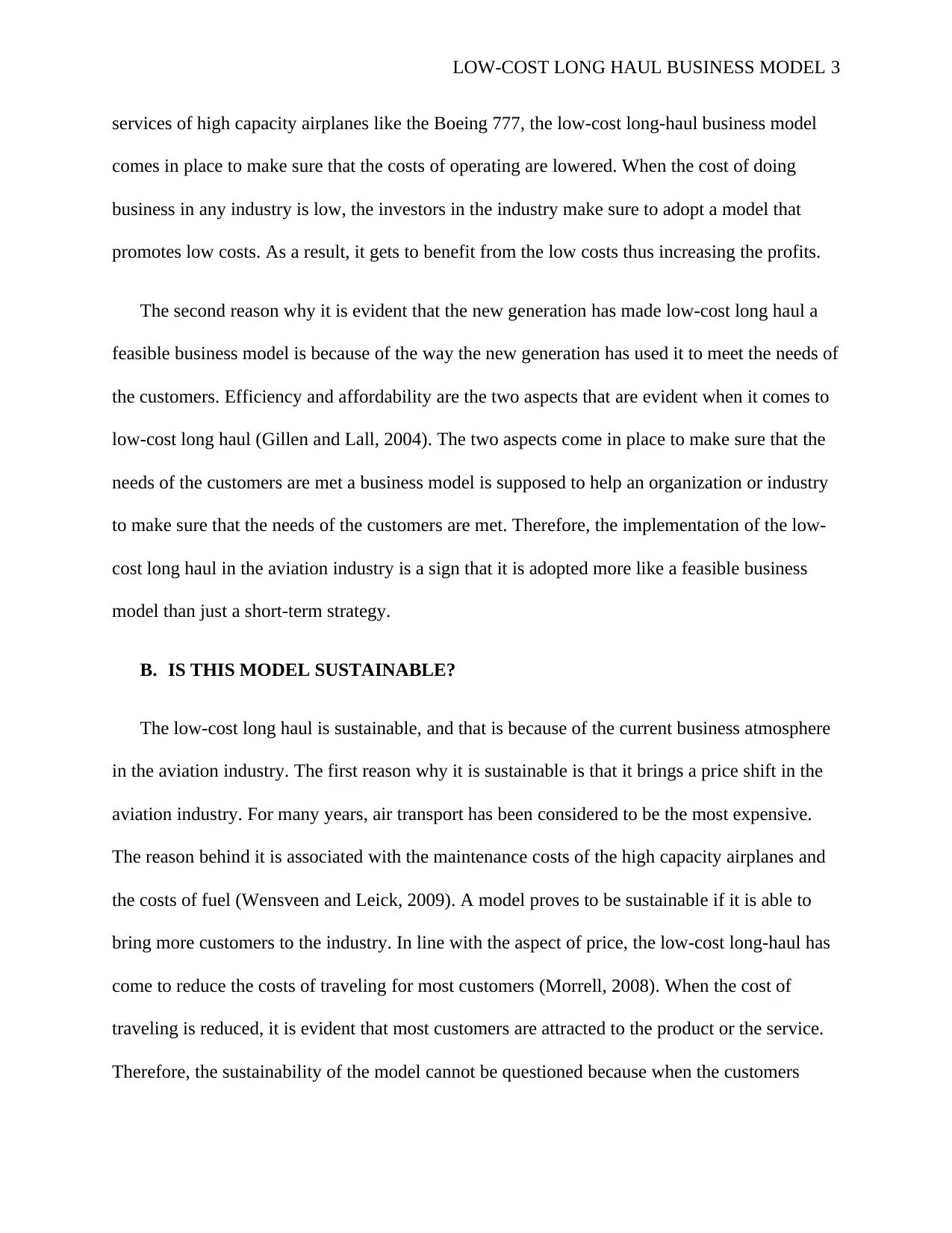
LOW-COST LONG HAUL BUSINESS MODEL 3
services of high capacity airplanes like the Boeing 777, the low-cost long-haul business model
comes in place to make sure that the costs of operating are lowered. When the cost of doing
business in any industry is low, the investors in the industry make sure to adopt a model that
promotes low costs. As a result, it gets to benefit from the low costs thus increasing the profits.
The second reason why it is evident that the new generation has made low-cost long haul a
feasible business model is because of the way the new generation has used it to meet the needs of
the customers. Efficiency and affordability are the two aspects that are evident when it comes to
low-cost long haul (Gillen and Lall, 2004). The two aspects come in place to make sure that the
needs of the customers are met a business model is supposed to help an organization or industry
to make sure that the needs of the customers are met. Therefore, the implementation of the low-
cost long haul in the aviation industry is a sign that it is adopted more like a feasible business
model than just a short-term strategy.
B. IS THIS MODEL SUSTAINABLE?
The low-cost long haul is sustainable, and that is because of the current business atmosphere
in the aviation industry. The first reason why it is sustainable is that it brings a price shift in the
aviation industry. For many years, air transport has been considered to be the most expensive.
The reason behind it is associated with the maintenance costs of the high capacity airplanes and
the costs of fuel (Wensveen and Leick, 2009). A model proves to be sustainable if it is able to
bring more customers to the industry. In line with the aspect of price, the low-cost long-haul has
come to reduce the costs of traveling for most customers (Morrell, 2008). When the cost of
traveling is reduced, it is evident that most customers are attracted to the product or the service.
Therefore, the sustainability of the model cannot be questioned because when the customers
services of high capacity airplanes like the Boeing 777, the low-cost long-haul business model
comes in place to make sure that the costs of operating are lowered. When the cost of doing
business in any industry is low, the investors in the industry make sure to adopt a model that
promotes low costs. As a result, it gets to benefit from the low costs thus increasing the profits.
The second reason why it is evident that the new generation has made low-cost long haul a
feasible business model is because of the way the new generation has used it to meet the needs of
the customers. Efficiency and affordability are the two aspects that are evident when it comes to
low-cost long haul (Gillen and Lall, 2004). The two aspects come in place to make sure that the
needs of the customers are met a business model is supposed to help an organization or industry
to make sure that the needs of the customers are met. Therefore, the implementation of the low-
cost long haul in the aviation industry is a sign that it is adopted more like a feasible business
model than just a short-term strategy.
B. IS THIS MODEL SUSTAINABLE?
The low-cost long haul is sustainable, and that is because of the current business atmosphere
in the aviation industry. The first reason why it is sustainable is that it brings a price shift in the
aviation industry. For many years, air transport has been considered to be the most expensive.
The reason behind it is associated with the maintenance costs of the high capacity airplanes and
the costs of fuel (Wensveen and Leick, 2009). A model proves to be sustainable if it is able to
bring more customers to the industry. In line with the aspect of price, the low-cost long-haul has
come to reduce the costs of traveling for most customers (Morrell, 2008). When the cost of
traveling is reduced, it is evident that most customers are attracted to the product or the service.
Therefore, the sustainability of the model cannot be questioned because when the customers
⊘ This is a preview!⊘
Do you want full access?
Subscribe today to unlock all pages.

Trusted by 1+ million students worldwide
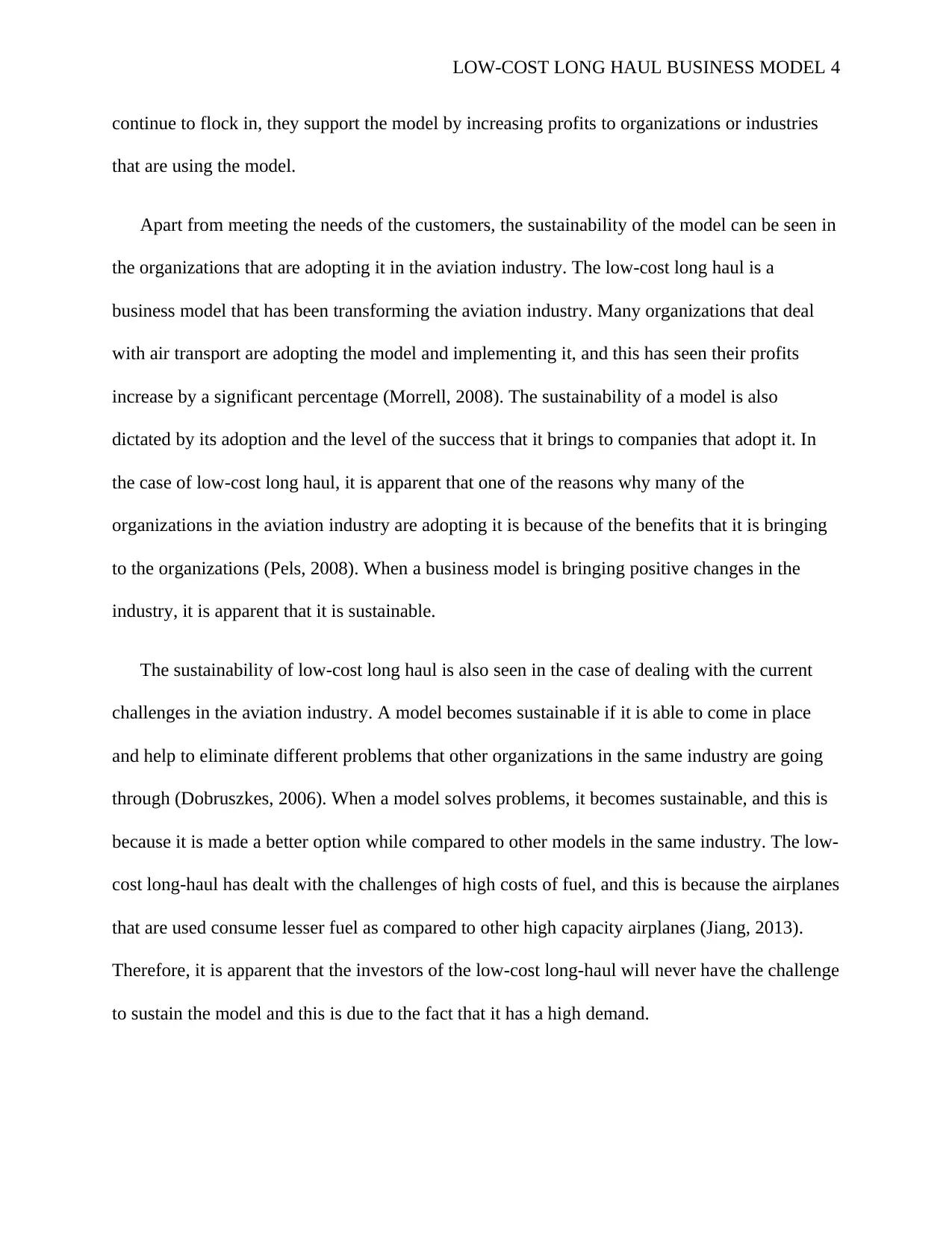
LOW-COST LONG HAUL BUSINESS MODEL 4
continue to flock in, they support the model by increasing profits to organizations or industries
that are using the model.
Apart from meeting the needs of the customers, the sustainability of the model can be seen in
the organizations that are adopting it in the aviation industry. The low-cost long haul is a
business model that has been transforming the aviation industry. Many organizations that deal
with air transport are adopting the model and implementing it, and this has seen their profits
increase by a significant percentage (Morrell, 2008). The sustainability of a model is also
dictated by its adoption and the level of the success that it brings to companies that adopt it. In
the case of low-cost long haul, it is apparent that one of the reasons why many of the
organizations in the aviation industry are adopting it is because of the benefits that it is bringing
to the organizations (Pels, 2008). When a business model is bringing positive changes in the
industry, it is apparent that it is sustainable.
The sustainability of low-cost long haul is also seen in the case of dealing with the current
challenges in the aviation industry. A model becomes sustainable if it is able to come in place
and help to eliminate different problems that other organizations in the same industry are going
through (Dobruszkes, 2006). When a model solves problems, it becomes sustainable, and this is
because it is made a better option while compared to other models in the same industry. The low-
cost long-haul has dealt with the challenges of high costs of fuel, and this is because the airplanes
that are used consume lesser fuel as compared to other high capacity airplanes (Jiang, 2013).
Therefore, it is apparent that the investors of the low-cost long-haul will never have the challenge
to sustain the model and this is due to the fact that it has a high demand.
continue to flock in, they support the model by increasing profits to organizations or industries
that are using the model.
Apart from meeting the needs of the customers, the sustainability of the model can be seen in
the organizations that are adopting it in the aviation industry. The low-cost long haul is a
business model that has been transforming the aviation industry. Many organizations that deal
with air transport are adopting the model and implementing it, and this has seen their profits
increase by a significant percentage (Morrell, 2008). The sustainability of a model is also
dictated by its adoption and the level of the success that it brings to companies that adopt it. In
the case of low-cost long haul, it is apparent that one of the reasons why many of the
organizations in the aviation industry are adopting it is because of the benefits that it is bringing
to the organizations (Pels, 2008). When a business model is bringing positive changes in the
industry, it is apparent that it is sustainable.
The sustainability of low-cost long haul is also seen in the case of dealing with the current
challenges in the aviation industry. A model becomes sustainable if it is able to come in place
and help to eliminate different problems that other organizations in the same industry are going
through (Dobruszkes, 2006). When a model solves problems, it becomes sustainable, and this is
because it is made a better option while compared to other models in the same industry. The low-
cost long-haul has dealt with the challenges of high costs of fuel, and this is because the airplanes
that are used consume lesser fuel as compared to other high capacity airplanes (Jiang, 2013).
Therefore, it is apparent that the investors of the low-cost long-haul will never have the challenge
to sustain the model and this is due to the fact that it has a high demand.
Paraphrase This Document
Need a fresh take? Get an instant paraphrase of this document with our AI Paraphraser
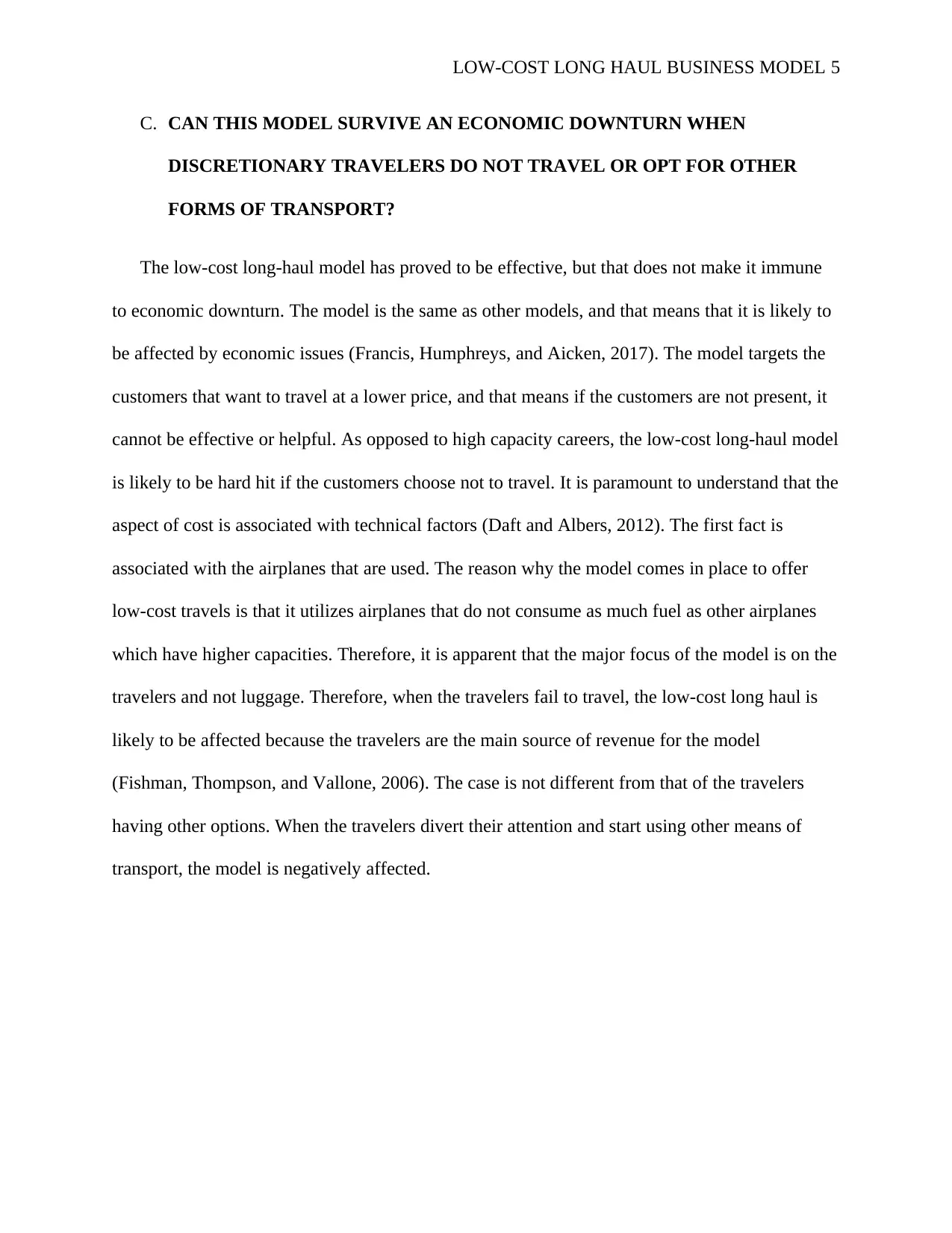
LOW-COST LONG HAUL BUSINESS MODEL 5
C. CAN THIS MODEL SURVIVE AN ECONOMIC DOWNTURN WHEN
DISCRETIONARY TRAVELERS DO NOT TRAVEL OR OPT FOR OTHER
FORMS OF TRANSPORT?
The low-cost long-haul model has proved to be effective, but that does not make it immune
to economic downturn. The model is the same as other models, and that means that it is likely to
be affected by economic issues (Francis, Humphreys, and Aicken, 2017). The model targets the
customers that want to travel at a lower price, and that means if the customers are not present, it
cannot be effective or helpful. As opposed to high capacity careers, the low-cost long-haul model
is likely to be hard hit if the customers choose not to travel. It is paramount to understand that the
aspect of cost is associated with technical factors (Daft and Albers, 2012). The first fact is
associated with the airplanes that are used. The reason why the model comes in place to offer
low-cost travels is that it utilizes airplanes that do not consume as much fuel as other airplanes
which have higher capacities. Therefore, it is apparent that the major focus of the model is on the
travelers and not luggage. Therefore, when the travelers fail to travel, the low-cost long haul is
likely to be affected because the travelers are the main source of revenue for the model
(Fishman, Thompson, and Vallone, 2006). The case is not different from that of the travelers
having other options. When the travelers divert their attention and start using other means of
transport, the model is negatively affected.
C. CAN THIS MODEL SURVIVE AN ECONOMIC DOWNTURN WHEN
DISCRETIONARY TRAVELERS DO NOT TRAVEL OR OPT FOR OTHER
FORMS OF TRANSPORT?
The low-cost long-haul model has proved to be effective, but that does not make it immune
to economic downturn. The model is the same as other models, and that means that it is likely to
be affected by economic issues (Francis, Humphreys, and Aicken, 2017). The model targets the
customers that want to travel at a lower price, and that means if the customers are not present, it
cannot be effective or helpful. As opposed to high capacity careers, the low-cost long-haul model
is likely to be hard hit if the customers choose not to travel. It is paramount to understand that the
aspect of cost is associated with technical factors (Daft and Albers, 2012). The first fact is
associated with the airplanes that are used. The reason why the model comes in place to offer
low-cost travels is that it utilizes airplanes that do not consume as much fuel as other airplanes
which have higher capacities. Therefore, it is apparent that the major focus of the model is on the
travelers and not luggage. Therefore, when the travelers fail to travel, the low-cost long haul is
likely to be affected because the travelers are the main source of revenue for the model
(Fishman, Thompson, and Vallone, 2006). The case is not different from that of the travelers
having other options. When the travelers divert their attention and start using other means of
transport, the model is negatively affected.
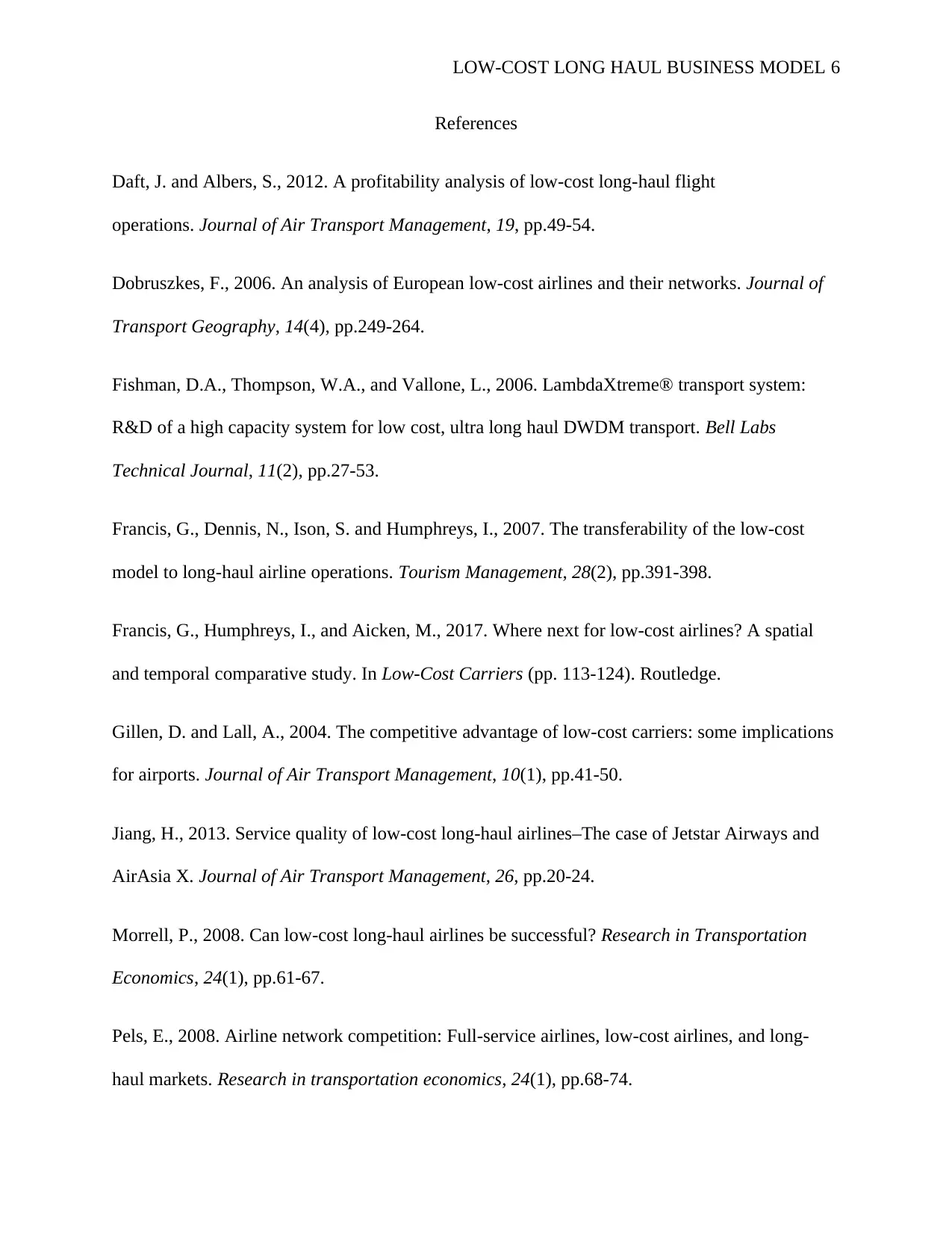
LOW-COST LONG HAUL BUSINESS MODEL 6
References
Daft, J. and Albers, S., 2012. A profitability analysis of low-cost long-haul flight
operations. Journal of Air Transport Management, 19, pp.49-54.
Dobruszkes, F., 2006. An analysis of European low-cost airlines and their networks. Journal of
Transport Geography, 14(4), pp.249-264.
Fishman, D.A., Thompson, W.A., and Vallone, L., 2006. LambdaXtreme® transport system:
R&D of a high capacity system for low cost, ultra long haul DWDM transport. Bell Labs
Technical Journal, 11(2), pp.27-53.
Francis, G., Dennis, N., Ison, S. and Humphreys, I., 2007. The transferability of the low-cost
model to long-haul airline operations. Tourism Management, 28(2), pp.391-398.
Francis, G., Humphreys, I., and Aicken, M., 2017. Where next for low-cost airlines? A spatial
and temporal comparative study. In Low-Cost Carriers (pp. 113-124). Routledge.
Gillen, D. and Lall, A., 2004. The competitive advantage of low-cost carriers: some implications
for airports. Journal of Air Transport Management, 10(1), pp.41-50.
Jiang, H., 2013. Service quality of low-cost long-haul airlines–The case of Jetstar Airways and
AirAsia X. Journal of Air Transport Management, 26, pp.20-24.
Morrell, P., 2008. Can low-cost long-haul airlines be successful? Research in Transportation
Economics, 24(1), pp.61-67.
Pels, E., 2008. Airline network competition: Full-service airlines, low-cost airlines, and long-
haul markets. Research in transportation economics, 24(1), pp.68-74.
References
Daft, J. and Albers, S., 2012. A profitability analysis of low-cost long-haul flight
operations. Journal of Air Transport Management, 19, pp.49-54.
Dobruszkes, F., 2006. An analysis of European low-cost airlines and their networks. Journal of
Transport Geography, 14(4), pp.249-264.
Fishman, D.A., Thompson, W.A., and Vallone, L., 2006. LambdaXtreme® transport system:
R&D of a high capacity system for low cost, ultra long haul DWDM transport. Bell Labs
Technical Journal, 11(2), pp.27-53.
Francis, G., Dennis, N., Ison, S. and Humphreys, I., 2007. The transferability of the low-cost
model to long-haul airline operations. Tourism Management, 28(2), pp.391-398.
Francis, G., Humphreys, I., and Aicken, M., 2017. Where next for low-cost airlines? A spatial
and temporal comparative study. In Low-Cost Carriers (pp. 113-124). Routledge.
Gillen, D. and Lall, A., 2004. The competitive advantage of low-cost carriers: some implications
for airports. Journal of Air Transport Management, 10(1), pp.41-50.
Jiang, H., 2013. Service quality of low-cost long-haul airlines–The case of Jetstar Airways and
AirAsia X. Journal of Air Transport Management, 26, pp.20-24.
Morrell, P., 2008. Can low-cost long-haul airlines be successful? Research in Transportation
Economics, 24(1), pp.61-67.
Pels, E., 2008. Airline network competition: Full-service airlines, low-cost airlines, and long-
haul markets. Research in transportation economics, 24(1), pp.68-74.
⊘ This is a preview!⊘
Do you want full access?
Subscribe today to unlock all pages.

Trusted by 1+ million students worldwide
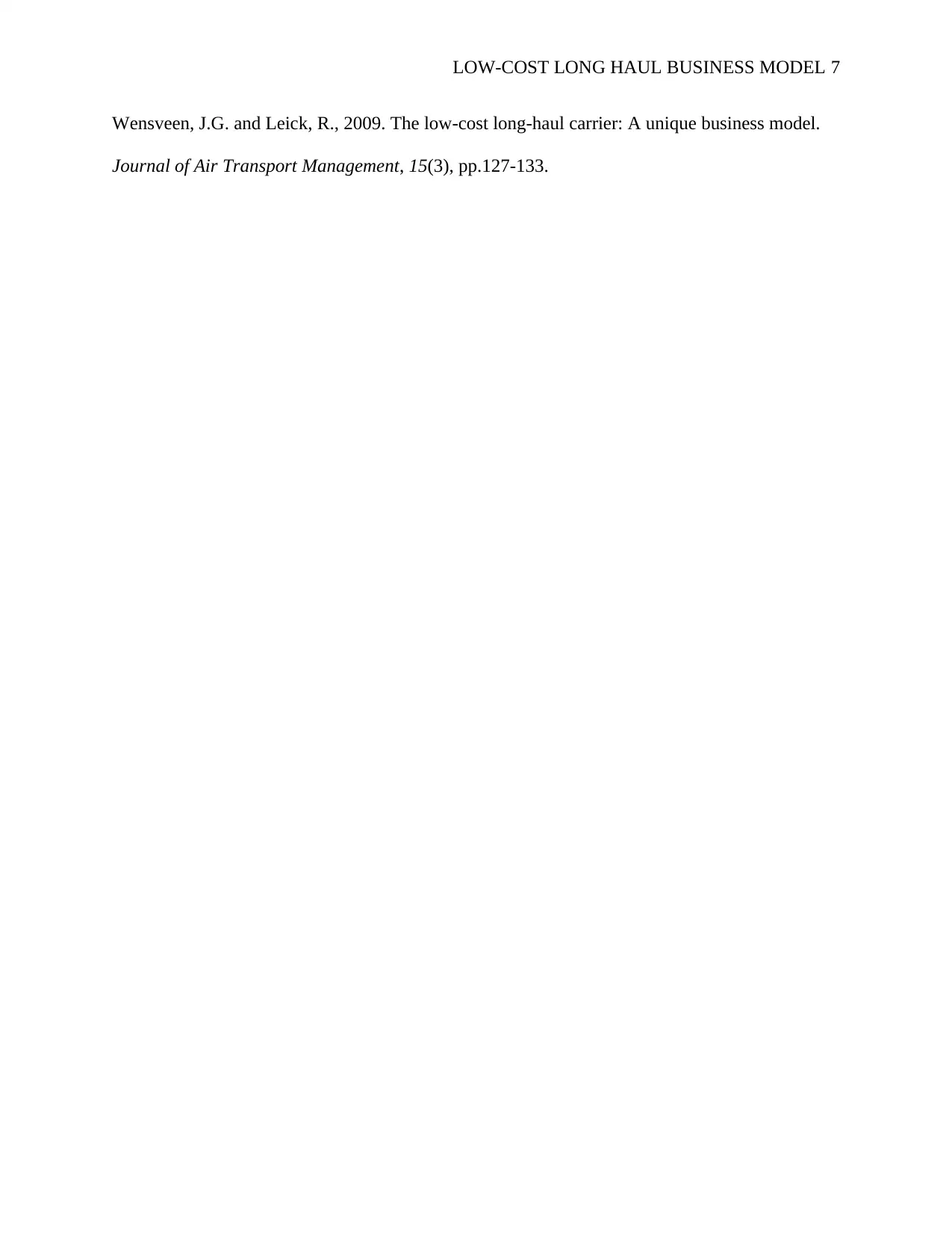
LOW-COST LONG HAUL BUSINESS MODEL 7
Wensveen, J.G. and Leick, R., 2009. The low-cost long-haul carrier: A unique business model.
Journal of Air Transport Management, 15(3), pp.127-133.
Wensveen, J.G. and Leick, R., 2009. The low-cost long-haul carrier: A unique business model.
Journal of Air Transport Management, 15(3), pp.127-133.
1 out of 7
Related Documents
Your All-in-One AI-Powered Toolkit for Academic Success.
+13062052269
info@desklib.com
Available 24*7 on WhatsApp / Email
![[object Object]](/_next/static/media/star-bottom.7253800d.svg)
Unlock your academic potential
Copyright © 2020–2025 A2Z Services. All Rights Reserved. Developed and managed by ZUCOL.





